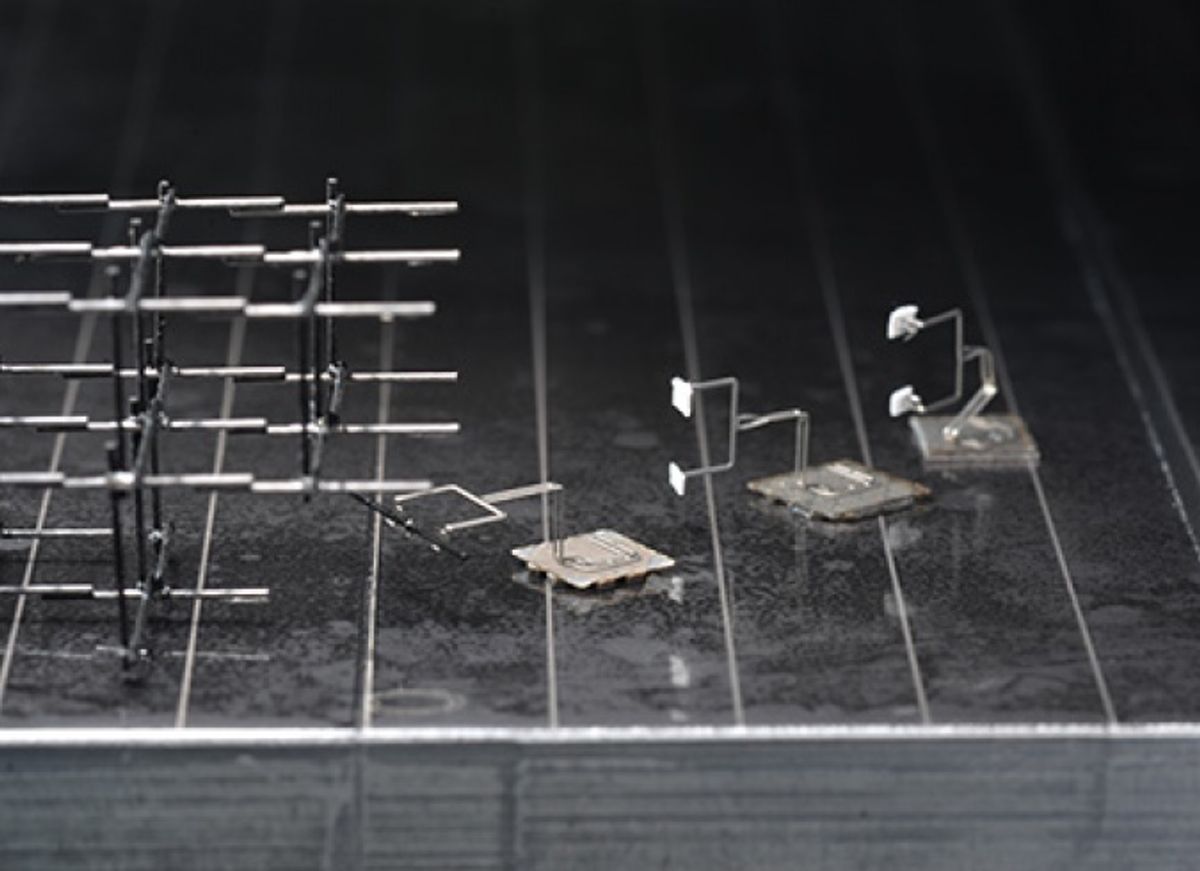A few years ago, SRI International introduced their MicroFactory platform, which uses hundreds of tiny robots (each one smaller than a dime) that cooperate to build macro-scale structures, like trusses, which can even contain integrated electronics. Such complex manufacturing requires cooperation between many different micro robots, each one outfitted to perform a specific task. Building a bunch of little custom bots is, we have to assume, a little bit tedious, so SRI has developed a tool shop for their MicroFactory that can make custom end-effectors for micro robots on-demand.
SRI’s micro robots are really just small magnets: all of the intelligence is built into the substrate that they travel on. Printed circuit boards drive them along electromagnetically, with the ability to control their speed and movement in two axes as well as rotationally. Here’s a video from 2014 that provides a good overview of the MicroFactory:
The video shows different micro robots doing lots of different tasks, but you’ll notice that fundamentally, the robots are identical, except for their end-effectors. These end-effectors have to be altered depending on what you want the micro robot to do, which in practice means you need to build a bunch of different micro robots. SRI has been experimenting with ways of adapting standardized micro robots into customized platforms designed for specific tasks by fabricating tools for them, which is a much more efficient way to do things:
It’s a little bit hard to tell what’s going on in these clips, so we talked to Ron Pelrine, principal scientist at SRI International, to get all of the details.
In the first clip, you’re looking at individual millimeter-scale magnets being driven into an “incubator” structure (glass slide with copper wire spacers sitting on the microfactory surface) that causes them to assemble into an array. In this particular case, the array forms a “V” shape, but it’s arbitrary, and different incubators can be used to create whatever shape you like. Once the array is formed, it can be controlled in multiple degrees of freedom as one single micro (or slightly less micro) robot, allowing it to act as a mobile manipulator.

The second clip shows how SRI’s micro robots can construct their own tools. This can be done on a single micro robot, or an array of micro robots that’s been formed into a larger manipulator, as in the first clip in the video. The active robot that’s doing all the work is made of two units that together are supporting a little bit of structure with a probe on it. Inside the dark-ish cylinder is a curable liquid that turns from liquid to solid as it dries. The micro robot with the probe picks up a droplet of the curable liquid, and then sticks it onto the corner of a waiting micro robot, where it hardens. Then, the micro robot zips over to the blue cylinder to daintily rinse its probe off to prevent unwanted build up of the curable liquid. This process is repeated over and over again until you’ve got the tool you need (a hook or a fork). It’s an additive manufacturing process that’s in some ways similar to 3D printing, in that over time, small bits of material come together to create something useful.
All of this takes place in an area of just a few square inches of space, and it vastly increases the utility of micro robots like these. Pelrine says you can think of the MicroFactory tool shop in much the same way as you would a tool shop in a macro factory that services a significant number of robots: rather than having to buy a bunch of special-purpose robots to complete tasks that may change, you just buy standardized robots, and outfit them with special purpose-tools that you fabricate yourself on-site. It’s faster, cheaper, and much more efficient. Additionally, a tool shop like this opens up possibilities for repairing tools (or even entire robots) on site, making the entire MicroFactory system more robust. Robustness, flexibility, and independence are going to be crucial if MicroFactories are deployed (say) in space, or perhaps on another planet, which are two places where they’d be incredibly useful.
Now that the micro robots can make their own tools, the same fleet of robots can be reconfigured to make different kinds of things. SRI has been focused on constructing strong, lightweight carbon fiber trusses with its MicroFactory, but they’ve recently started developing ways to make skins. Laying skins on top of arrays of trusses creates sandwich panels, which are a lightweight and very stiff structural component commonly used to make durable walls and roofs. Pelrine says that we should see some examples of this new construction in the next few months.
SRI is also working on a new way of controlling magnetic micro robots: levitation. Instead of sliding locomotion (which is relatively low precision), magnetic levitation could allow the micro robots to be positioned at a resolution of something like 200 nanometers (!). That level of precision in such an inherently low cost system could, according to Pelrine, offer very competitive advantages over conventional automation.
He explained that, eventually, the MicroFactory technology could expand outside of manufacturing, and achieve integration with other robotic systems: imagine micro robots “living” inside larger robots, monitoring them and performing maintenance and repairs. Borg nanites, basically, except not evil. We hope.
“Self-Assembly of Milli-scale Robotic Manipulators: A Path to Highly Adaptive, Robust Automation Systems,” by R. Pelrine, A. Wong-Foy, A. Hsu, and B. McCoy, will be presented at the International Conference on Manipulation, Automation, and Robotics on Small Scales (MARSS) in Paris this July.
[ SRI ]
Evan Ackerman is a senior editor at IEEE Spectrum. Since 2007, he has written over 6,000 articles on robotics and technology. He has a degree in Martian geology and is excellent at playing bagpipes.



